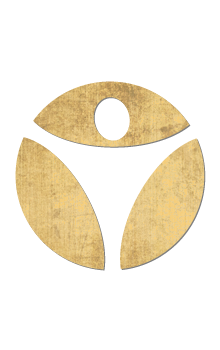Am I doing pigeon pose correctly? Frequently submitted student questions for pigeon pose!
- Updated on: October 5, 2021
Common questions:
- When is Pigeon Pose contraindicated?
- What do I do if I feel pain in my front knee in Pigeon Pose?
- What do I do if I feel pinching in my back?
- What exactly are my hips supposed to be doing in Pigeon Pose?
- Should my back be rounded or straight?
- How close to my chest should my front foot be? Am I doing it wrong if my calf is too close to my chest?
- Should my foot be perpendicular to my body?
- If I feel a stretch in my outer leg, is that the same as my hip/glutes?
- Am I doing it wrong if I can’t externally rotate my leg so that the side of the shin is down but I still feel a stretch in my outer hips?
- Should both sides of my body be feeling the same?
- How much weight should I put into my hands/arms?
- Should my hands rest on the floor, on blocks, or on my elbows?
- Can I do this pose using my bed as a raised surface?
- Should I do this pose at the end of a session?
- How long should I hold this pose?
- To go deeper in this pose, would I put more weight into my hip? If so, how?
- When is Pigeon Pose contraindicated?
- Spinal injury, including bone spurs, disc issues and fused vertebrae
- Acute migraine or tension headache
- Blood pressure disorders
- Acute knee and/or hip injuries
- Acute sciatica
- Pregnancy – consult your healthcare provider
- What do I do if I feel pain in my front knee in Pigeon Pose?
- Pain in the front knee is often an indication that the hip is not fully externally rotated, so the knee is trying to take on the rotation instead. This opens the knee up to injury and should be avoided. See the section above to learn how to modify Pigeon Pose to alleviate pain in the front knee and practice the pose safely and more comfortably.
- What do I do if I feel pinching in my back?
- If you feel pinching in your back, you are likely over-working your back and/or not engaging your core. Feeling pinching in the back signals the potential for injury. Refer to the section above for ways to modify this pose to alleviate excessive back pain and pinching.
- What exactly are my hips supposed to be doing in Pigeon Pose?
- The hip of the front leg will be externally rotating. This means your inner thigh will be facing the sky and the outer thigh will be facing the ground. The hip of the back leg will be extending straight behind you so that the top of the thigh is facing the ground and the back of the thigh is facing the sky. Both hips are squared to the front of the mat facing the short edge.
- Should my back be rounded or straight?
- Your back should be straight.
- How close to my chest should my front foot be? Am I doing it wrong if my calf is too close to my chest? Should my foot be perpendicular to my body?
- How close your front foot and calf are to your chest will largely depend on the degree of flexibility in your hips. The aim is to get your torso as close to your front leg as you comfortably can while maintaining proper alignment. Having the front foot perpendicular to the body will intensify the stretch and promote best alignment in the front leg.
- If I feel a stretch in my outer leg, is that the same as my hip/glutes?
- The muscles of the outer leg are different than the hips and glutes, but they are closely related. The hips are a joint that connects the legs to the torso. The glutes are the primary muscles of your butt. Many people will feel a stretch in the outer legs as well as the hips and glutes.
- Am I doing it wrong if I can’t externally rotate my leg so that the side of the shin is down, but I still feel a stretch in my outer hips?
- The proper alignment is to have the outside of your shin resting on the ground, along with the outside of your thigh. However, if your hips are overly tight or restricted, you may have difficulty finding the full rotation. In this case, it is recommended to modify the pose. See the modifications section above to find the modification that will best serve your needs.
- Should both sides of my body be feeling the same?
- In this pose, the two sides of the body are in two different positions. Because of this, they will be experiencing different sensations as different muscle groups are being stretched and strengthened.
- How much weight should I put into my hands/arms?
- The hands/arms are only there for additional support. They should not be receiving the full weight of the pose. Evenly distribute the weight between your thighs, glutes and core with minimal weight in your hands/arms.
- Should my hands rest on the floor, on blocks, or on my elbows?
- This will depend on your flexibility level. The fuller expression of the pose is to have the forearms on the ground, but you may need to modify the pose by placing your hands on the ground or on blocks as you work to develop the necessary flexibility.
- Can I do this pose using my bed as a raised surface?
- Yes. It works best with a bed that is higher off the ground, as low profile beds may be too short. To do this, stand facing the side of the bed. Shift your weight into your left leg to raise your right knee and foot to the bed. Place it on the bed as you would on the floor. Once in position, hinge forward by lifting and reaching the chest toward the opposite edge of the bed (not toward your leg). Repeat on the other side.
- Should I do this pose at the end of a session?
- There is no defined timing for practicing this pose during your session. However, you may find it easier and more comfortable to practice it later in your session so that your hips and legs have a chance to warm up first.
- How long should I hold this pose?
- There is no set time for holding any pose. However, a good starting point is 5-10 breaths or 30-90 seconds.
- To go deeper in this pose, would I put more weight into my hip? If so, how?
- The weight should remain evenly distributed through both hips during the pose. You can create intensity by deepening the forward fold (lowering the belly closer to the ground) and pressing the feet into the ground.
Want more tips for how to do pigeon pose? Here are some additional resources!
Recent Posts
Categories
Related Articles

Yoga For Men – How To Do A Pigeon Stretch
October 5, 2021
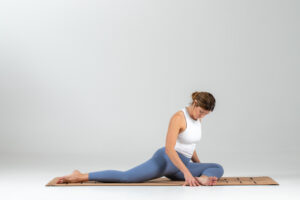
Common Mistakes Beginners Make In Pigeon Pose
November 5, 2021
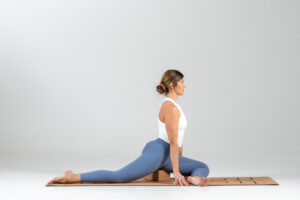
Related Articles
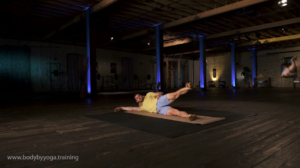
Gentle Yoga
Stretching and Strengthening your hips
In this workout we start slow to warm up your hips. Utilizing low impact workouts like this can be important for beginners and yoga veterans
February 21, 2024
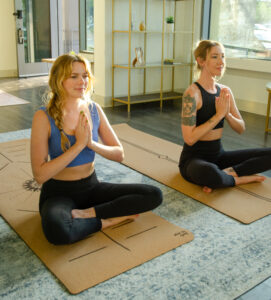
Yoga For Beginners
Hatha vs Power yoga
We’ve created our own unique style of slow burn power yoga that combines Hatha yoga, power yoga, bodyweight exercises and physical therapy. This way in
November 9, 2022

Common Mistakes
The importance of maintaining correct alignment
Everything in your body is connected, so when one muscle isnt aligned properly it can be a slippery slope to injury. Building a solid foundation
October 26, 2022
